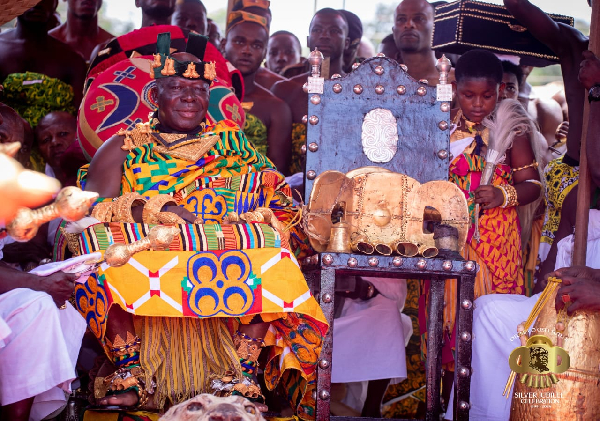The history of Ghana would not be complete without the history of the Ashantis or, more correctly, the Asantes.
This major Akan ethnic group, known for its distinct culture and remarkable history, still remains relevant to this day.
However, what many may not know is that the Asantes derived their name from a bloody and violent time in their history.
This article will give readers a brief history of the Asante empire and how the name ‘Asante’ came about.
In the Akan Twi language, the word ‘Asante’ comes from the phrase ‘ɔsa nti’, meaning “because of war.”
‘ɔsa’ translates to “war” and ‘nti’ means “because”. Thus, Asante (sometimes rendered ‘Ɛsa nti’) literally translates to “because of war.”
As one history website notes, the name “reflects the origins of the Asante people” who were “born out of conflict.”
A history of oppression, rebellion and unification
The Asantes were said to have migrated from the ancient Gaana Empire in the 17th Century.
By then, the kingdom was initially a group of small independent states.
These states – including Kumasi, which was ruled by the Oyoko clan – had long paid tribute to the Denkyira, a powerful Akan kingdom to the south.
All that changed when Osei Tutu I was born, according to Encyclopedia Britannica. As Kumasi’s chief, Osei Tutu, matured, he was sent to the court of the King of Denkyira as a servant and swordbearer.
There, he was said to have eloped with the king’s younger sister.
To avoid the death penalty, he escaped to the state of Akwamu, where he gained popularity and met the priest Okomfo Anokye.
Upon the death of his uncle, King Obiri Yeboah, he was summoned by the Kumasi royals to come and lead.
When Osei Tutu returned from exile in Akwamu, he brought Anokye back to Kumasi.
It was there that Anokye is said to have summoned the Golden Stool (Sika Dwa) from heaven to solidify his leadership.
By then, many of the city-states under the Denkyira Kingdom had begun to rebel.
It was at this point where Osei Tutu “came to realise… that a fusion of the small separate Asante kingdoms was necessary to withstand their powerful Denkyera \[Denkyira] neighbours.”
With the aid of the priest Okomfo Anokye, Osei Tutu initiated an alliance and under their leadership, “the other Asante kingdoms merged with Kumasi.”
Therefore, the Asante union was not a peaceful merger but a military alliance formed ‘because of war.’
The confederation’s armies then turned on Denkyira. According to historical accounts, between 1699 and 1701, the united Asante forces decisively defeated the Denkyira war leader Gyakari, destroying Denkyira power and gaining independence.
Osei Tutu was then installed as the first Asantehene (king of the Asante).
Some traditions also say that as the captured Denkyira king Gyakari (often called “Ntim”) was about to be executed, he uttered the words “esa nti” (‘because of war’).
Furthermore, the meaning has taken on broader symbolism.
The GhanaRemembers website notes that the name Asante “reflects the origins of the Asante people” as a nation born of conflict.
Even today, Asante cultural motifs celebrate this martial heritage. For example, the national motto of the Asante (often quoted in Twi) is “Kum apem a, apem aba” – literally “Kill a thousand, a thousand will rise.”
This saying (and the porcupine ‘kɔtɔkɔ’, the Asante totem animal, with its quills) captures the idea that no matter how many people are slain, more will rise to protect the nation.
Asante or Ashanti?
Over time, the term ‘Asante’ was adapted by outsiders.
However, in the late 18th and 19th centuries, the British and other European observers often spelt it “Ashanti” (or “Ashantee”,etc.).
Encyclopedia Britannica explains that the form “Ashanti” arose because British officials transcribed Asante as “as-hanti,” subsequently dropping the hyphen in English usage.
This spelling became conventional in colonial literature and persists today in many English contexts.
Despite the different spellings, the two names refer to the same people and history.
Watch a video documentary of the Asantes below:
ID/AE


